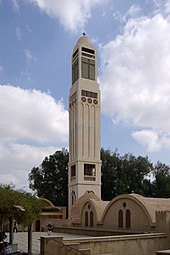Sketic desert
| Wadi Natrun in hieroglyphics | |||||||
|---|---|---|---|---|---|---|---|
Sechet-hemat Sḫ.t-ḥm3.t salt field |
|||||||
The Sketian Desert , also known as Skete or Sketis Desert , is a desert valley ( wadi ) that is located as the foothills of the Sahara ( Libyan Desert ) about 100 km southeast of the Egyptian port city of Alexandria and southwest of the Nile Delta , halfway on the road to Giza . It is also called Wadi an-Natrun ( Arabic وادي النطرون, DMG Wādī an-Naṭrūn ‚Natrontal ') known. The name Sketis is interpreted in the Christian-Coptic understanding as derived from the Greek " asceticism ", but is derived from the ancient Egyptian Sechet-hemat (salt field). There was a center for ancient glass production .
history
The Wadi an-Natrun got its name as a mining site for naturally occurring soda from soda lakes , which was used for mummification and glass production, among other things. The Egyptian soda was exported by the Phoenicians to the Mediterranean via Alexandria . It was relatively pure and contained more than 40% sodium oxide (data referring to oxide as usual in petrology , but in fact sodium carbonate is present) and up to 4% calcium carbonate . From 30 BC From BC to AD 359, the center of Egyptian glass production was located there, mainly for export to the Roman Empire .
The Sketis near Nitria is next to the cell desert one of the areas southwest of the Nile Delta where one of the basic forms of Christian monasticism developed in the second half of the 4th century , namely that of the hermit community. Christians retreated here, following the example of Saint Anthony , to renounce the world in asceticism. Among them were the Saints Arsenius , Makarios of the Egyptians (who was the spiritual center of this hermit colony) and Makarios of Alexandria who presided over the community as abbot . The monasteries were repeatedly subjected to attacks by the Berbers and Bedouins . Abbas Makarios attributed this to the sins of the monks; He said of the devastation of the Sketis to the brothers: “When you see that a kellion is being built near the lake, then you know that it is near to desolation. If you see trees, then it is at the door, and if you see boys, then take your cloaks and go away. ”(Apophthegmata 458)
The further meaning for the term skite is derived from the name, which means, among other things, a small chapel or church with some separately surrounding hermit or cloister houses . The term Sketis was already used as a collective term for the other hermit settlements in the western Nile Delta among the late antique monk writers who described the life of the hermits.
Today there are still four monasteries in this desert valley cut through by the Alexandria – Cairo motorway:
- Monastery of St. Makarios - Dair Anba Maqar
- Boromaeos Monastery - Dair al-Baramus
- Syrian Monastery - Dair as-Suryan
- Monastery of St. Pischoi - Dair Anba Bischoi
Web links
literature
- Michael Hesemann : Jesus in Egypt. The secret of the Copts. Herbig, Munich 2012, ISBN 978-3-7766-2697-1 .
Individual evidence
- ↑ Ahmed Saleh Saleh, Wageih George Adel, Mohamed Helmi Fatma: Study of glass and glass-making processes at Wadi El-Natrun, Egypt in the Roman Period 30 BC to 359 AD , in: Studies in Conservation , Vol. 17, No. 4, November 1, 1972, pp. 143-172, doi : 10.1179 / sic.197.2.015 .
Coordinates: 30 ° 25 ′ 55 " N , 30 ° 14 ′ 48.8" E

